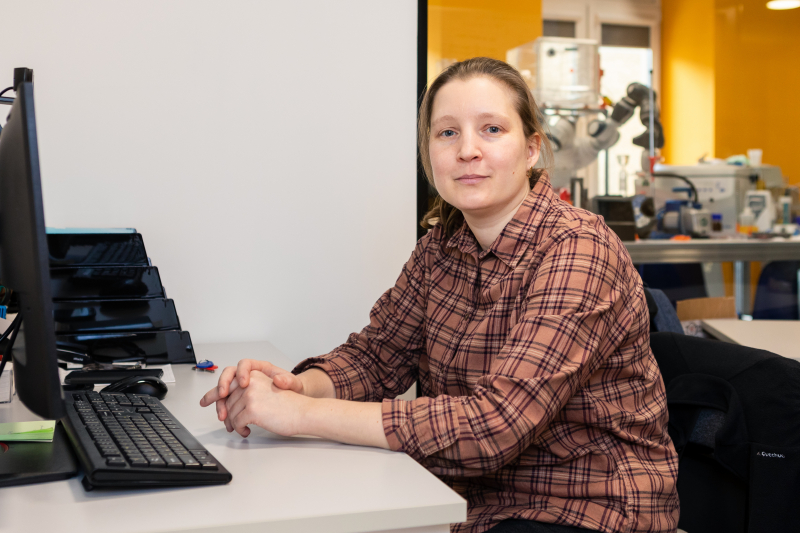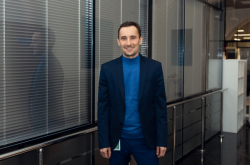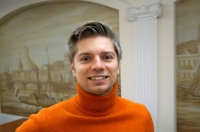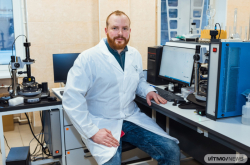Why are you interested in liquid crystals?
Essentially, I’ve always worked with them. Starting from my PhD studies, where I analyzed photochemistry of guest chiral molecules in soft condensed media – so mainly liquid crystals. For the admixture, we used provitamin D, which can be found in the human skin; it’s what starts the production of vitamin D when subjected to sunshine. Together with my research supervisor, we wanted to develop a liquid crystal sensor to test how effective artificial and natural light sources are for vitamin D accumulation. But it turned out that different mechanisms are at play in provitamin D reactions in liquid crystals and in the skin. This chiral molecule (not identical to its mirror image) turned into a chain of isomers when subjected to light, which greatly influenced the liquid crystal’s optical and structural properties. That’s why at some point I got more interested in this particular field and not photochemistry or photoisomerization. And that was the project I continued to expand on abroad.
Tell us more about your experience of collaborating with universities in Europe and Scandinavia.
I’ve been working with universities outside of the Ukraine since 2013. First, I took part in a six-month program for young scientists organized by the Institute for Cancer Research at the Oslo University Hospital. Back then, I was still studying vitamin D and collaborated with clinicians and biophysicists. They approached this project from the perspective of human health and I demonstrated the tools, evaluation and analysis methods used by physicists.
My next trip came two years later. I learned that a researcher at the University of Bordeaux is looking for a specialist who would run experiments in the field of properties and structures of liquid crystals. We got in touch, won a joint Erasmus grant, and off I went. Since then, my work has almost always followed a set algorithm: submitting an application, winning a grant, and doing research in another country. For example, two years after my project in France, I joined the same group as a winner of the Marie Skłodowska-Curie grant. And I still collaborate with these researchers.
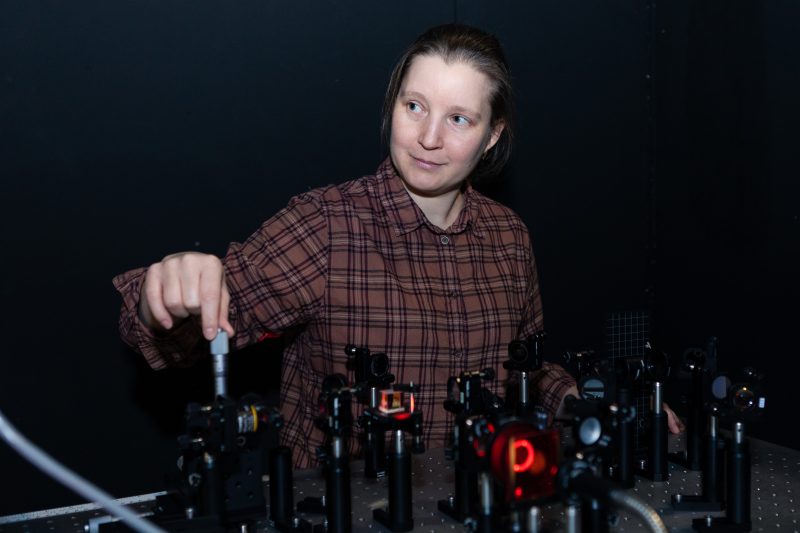
Tatiana Orlova setting up a liquid crystal sample relatively to a passing focused Gaussian ultraviolet beam to get a spot of light of the necessary diameter. The diameter is defined by the distance between the focusing lens and the sample. The beam itself is invisible and the red light is used to visualize the systems created by the beam in the sample. Photo by Dmitry Grigoryev, ITMO.NEWS
What did you gain from that experience?
It was very useful. In terms of one’s professional growth, such trips are a great meeting point for experts in different fields. Our research group had specialists with many different skills and views on the same issues.
However, it’s also an interesting experience in terms of your daily life. It’s one thing to visit a country as a tourist and another – to spend several months or years there and be able to integrate into society. Every university that I visited had an international staff support office, not unlike the one at ITMO. Such offices help you settle in, collect the necessary papers, find accommodation, or sort out any administrative issues. In about half a year, I’d usually get the hang of the unspoken rules of the country. And, naturally, I made a lot of new friends and expanded my professional network.
What advice would you give to fledgling scientists?
Don’t be shy to join various collaborations or apply for projects, and don’t give up. I know several people who were applying for the Marie Skłodowska-Curie grant, which is highly competitive – only about 6% of the submitted projects get the support. Oftentimes, researchers don’t win on their first attempt, they get discouraged, and give up. They keep doing research but they never get the spark back. You have to learn to constantly try without throwing in the towel.
How did you learn about the ITMO Fellowship & Professorship program and why did you decide to participate?
In 2019, I met Ekaterina Skorb, the head of ITMO’s Infochemistry Scientific Center, at a conference in Switzerland. She told me about the program, as well as spoke about the research done at the center and at ITMO. Then, when I first arrived at ITMO in December 2020, I started by launching the Structured and Dynamic Soft Matter research group with several of my colleagues.
It’s a whole other level to lead your own group and manage your project on a permanent basis – it’s very different from constantly moving between countries and switching research groups. And I think that every researcher has to reach this level. Naturally, there are people who like being led, but I believe that many, just like me, want to try and head their own group to work in brand new fields.
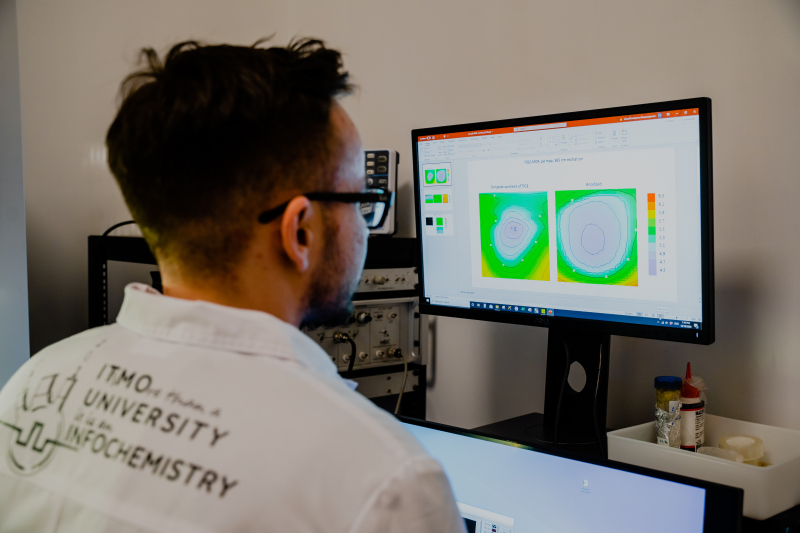
ITMO's Infochemistry Scientific Center. Photo by Dmitry Grigoryev, ITMO.NEWS
Which projects do you work on at ITMO?
I spent a good amount of time after arrival setting up the lab: doing renovations, purchasing and installing the equipment. This was finished by summer 2021 and in September we launched our first experiments, just as two new members joined my team – PhD student Darina Darmoroz and first-year Master’s student Anastasia Piven.
We ambitiously named the lab Structured and Dynamic Soft Matter – for now the only soft matter we work with is liquid crystals. The word “dynamic” dates back to an article we published with my colleagues from the University of Bordeaux on the first light-induced dynamic structure in a liquid crystal. This structure moves perpetually when subjected to light. It’s a promising study for microscale transport systems, soft robotics, and smart materials because it essentially turns the energy of light into mechanical motion. And “structured” refers to the fact that every effect that we’ve demonstrated is connected to the fact that molecules in liquid crystals self-organize into 3D localized topological structures.
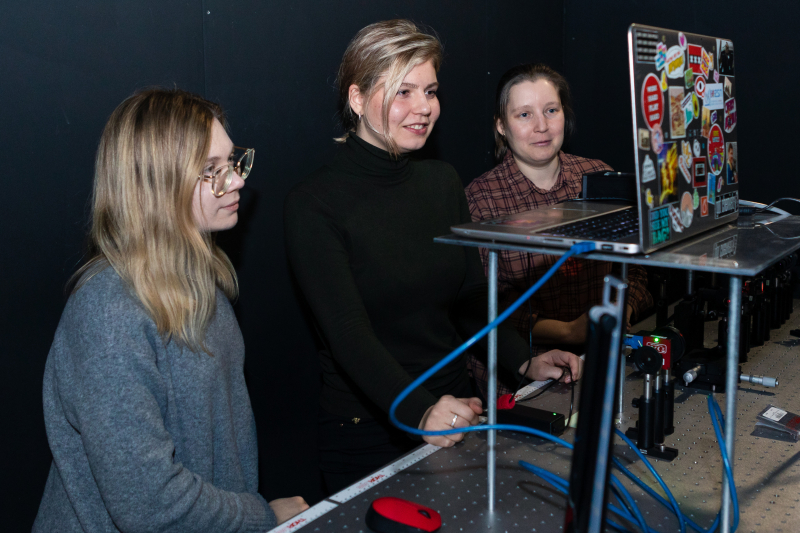
Anastasia Piven, Darina Darmoroz, and Tatiana Orlova at the lab. Photo by Dmitry Grigoryev, ITMO.NEWS
You entered the ITMO Fellowship & Professorship program with a project called Self-Assembling Supramolecular Architectures in Chiral Soft Condensed Media. What is it about?
First, let’s talk about supramolecular structures. If in 3D space the rod-shaped molecules of a liquid crystal are parallel to each other and turn in relation to one another along one of the axes, they form a classic supramolecular helix of a chiral nematic liquid crystal. In the case of homogenous liquid crystals the material’s properties will be determined only by the supramolecular helix pitch distance and won’t change in different areas of the sample. But imagine that we cut off a small piece of the helix and start heterogeneously rearranging it in a constricted space. In other words, we would turn a regular uniform helix into a complexly organized and spatially heterogeneous one. This additional structural complexity occurs on a supramolecular level and brings with it a new dynamic and properties for localized supramolecular structures.
Why are these architectures self-assembling? Let’s say we point a source of light at a specific point in a sample. The guest molecules engage in a photochemical reaction, the helix pitch distance changes, and then the liquid crystal is, so to say, free to choose how to organize itself in the 3D space. We change the properties of the helix but then the suprastructure formation is determined by the free energy of the crystal and its relaxation. In chemistry, researchers often rely on another approach, where atoms are aligned one by one to form a specific structure. In our case, it’s different, as the crystal does everything of its own accord. But the result depends on the material’s dimensional and microscopic properties, as well as on the parameters of the recording beam of light.
Where can we apply such research? First, in optics, which is classic for liquid crystals. What’s more interesting, is another nascent field: the creation of materials, in which macroscopic movement is induced by light. Researchers are now developing polymers and elastomers that can be used in soft robotics. For instance, if we point a beam of light on a flower made from an elastomer film, it will roll into a bud. It will keep moving as long as there is light. But to make the flower assume its initial shape, you will have to either change the wavelength of the light or warm it up, it will have to be subjected to a new stimulus. We want to develop such dynamic systems that would be based on light-controlled liquid crystals without the polymer compound.
This film can be compared to a remotely controlled robot – it can be placed anywhere and doesn’t have to be connected to any kind of electrodes, you only have to shine the light on it. The result of such research can be applied in the creation of composite materials or transport systems, as well as in biology and medicine.
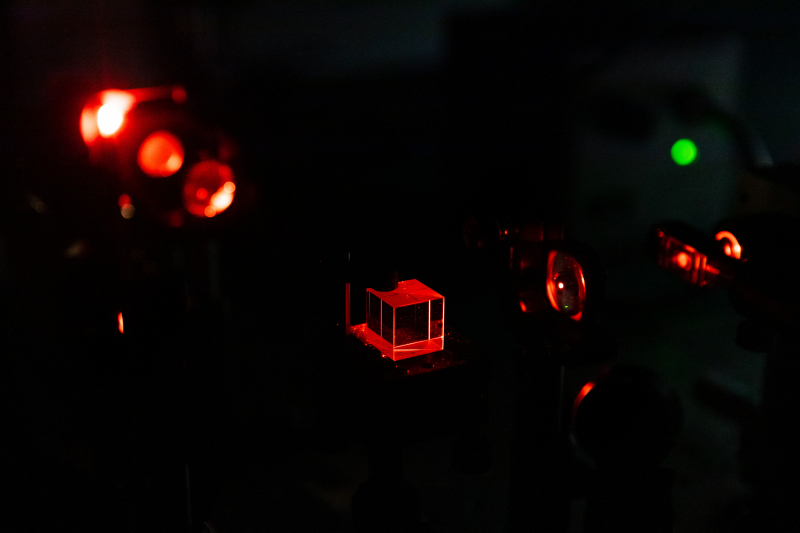
Part of the optical system forming the illumination with the wide red beam of light. The green light indicates that the laser is on. Photo by Dmitry Grigoryev, ITMO.NEWS
What are you planning to achieve by the end of the program?
I want my lab to grow in two directions. We currently work with different types of structures, monitoring their behavior, and control the related processes. Next, we are planning to work on optical effects and microscale transport systems. In time, I’d love to reach out to industrial partners – there are many Russian and international companies interested in new materials.
What do you do in your free time?
In September, I joined a fitness class, because although I love my job I find it strange to spend all my time at work.
I have also been a big reader since childhood. To unwind with a book, I usually opt for fantasy or sci-fi. For instance, it took me mere hours to get through Susanna Clarke’s Piranesi. And when I am in the mood for more serious topics, I opt for books on sociology and literature, or memoirs. The last book of this kind that I read contained lectures on the Russian literature of the 20th century, which turned out to be quite insightful.
